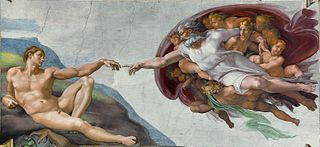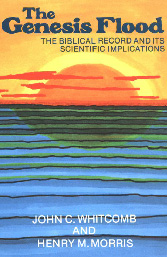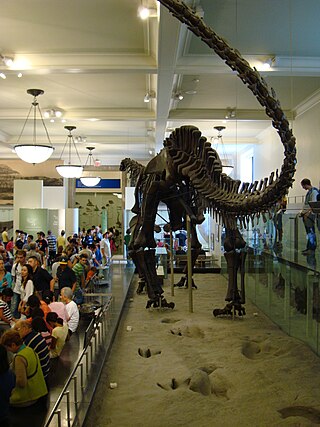
Creation science or scientific creationism is a pseudoscientific form of Young Earth creationism which claims to offer scientific arguments for certain literalist and inerrantist interpretations of the Bible. It is often presented without overt faith-based language, but instead relies on reinterpreting scientific results to argue that various myths in the Book of Genesis and other select biblical passages are scientifically valid. The most commonly advanced ideas of creation science include special creation based on the Genesis creation narrative and flood geology based on the Genesis flood narrative. Creationists also claim they can disprove or reexplain a variety of scientific facts, theories and paradigms of geology, cosmology, biological evolution, archaeology, history, and linguistics using creation science. Creation science was foundational to intelligent design.

Young Earth creationism (YEC) is a form of creationism which holds as a central tenet that the Earth and its lifeforms were created by supernatural acts of the Abrahamic God between about 6,000 and 10,000 years ago. In its most widespread version, YEC is based on the religious belief in the inerrancy of certain literal interpretations of the Book of Genesis. Its primary adherents are Christians and Jews who believe that God created the Earth in six literal days. This is in contrast with old Earth creationism (OEC), which holds literal interpretations of Genesis that are compatible with the scientifically determined ages of the Earth and universe. It is also in contrast to theistic evolution, which posits that the scientific principles of evolution, the Big Bang, abiogenesis, solar nebular theory, age of the universe, and age of Earth are compatible with a metaphorical interpretation of the Genesis creation account.

Flood geology is a pseudoscientific attempt to interpret and reconcile geological features of the Earth in accordance with a literal belief in the Genesis flood narrative, the flood myth in the Hebrew Bible. In the early 19th century, diluvial geologists hypothesized that specific surface features provided evidence of a worldwide flood which had followed earlier geological eras; after further investigation they agreed that these features resulted from local floods or from glaciers. In the 20th century, young-Earth creationists revived flood geology as an overarching concept in their opposition to evolution, assuming a recent six-day Creation and cataclysmic geological changes during the biblical flood, and incorporating creationist explanations of the sequences of rock strata.

George McCready Price was a Canadian creationist. He produced several anti-evolution and creationist works, particularly on the subject of flood geology. His views did not become common among creationists until after his death, particularly with the modern creation science movement starting in the 1960s.

The Genesis Flood: The Biblical Record and its Scientific Implications is a 1961 book by young Earth creationists John C. Whitcomb and Henry M. Morris that, according to Ronald Numbers, elevated young Earth creationism "to a position of fundamentalist orthodoxy".

The Paluxy River, also known as Paluxy Creek, is a river in the U.S. state of Texas. It is a tributary of the Brazos River. It is formed by the convergence of the North Paluxy River and the South Paluxy River near Bluff Dale, Texas in Erath County and flows a distance of 29 miles (47 km) before joining the Brazos just to the east of Glen Rose, Texas in south central Somervell County.

Robert Vance Gentry was an American young Earth creationist and nuclear physicist, known for his claims that radiohalos provide evidence for a young age of the Earth.

The Kayenta Formation is a geological formation in the Glen Canyon Group that is spread across the Colorado Plateau province of the United States, including northern Arizona, northwest Colorado, Nevada, and Utah. Traditionally has been suggested as Sinemurian-Pliensbachian, but more recent dating of detrital zircons has yielded a depositional age of 183.7 ± 2.7 Ma, thus a Pliensbachian-Toarcian age is more likely. A previous depth work recovered a solid "Carixian" age from measurements done in the Tenney Canyon. More recent works have provided varied datations for the layers, with samples from Colorado and Arizona suggesting 197.0±1.5-195.2±5.5 Ma, while the topmost section is likely Toarcian or close in age, maybe even recovering terrestrial deposits coeval with the Toarcian Oceanic Anoxic Event. This last age asignation also correlated the Toarcian Vulcanism on the west Cordilleran Magmatic Arc, as the number of grains from this event correlate with the silt content in the sandstones of the upper layers.

A fossil track or ichnite is a fossilized footprint. This is a type of trace fossil. A fossil trackway is a sequence of fossil tracks left by a single organism. Over the years, many ichnites have been found, around the world, giving important clues about the behaviour of the animals that made them. For instance, multiple ichnites of a single species, close together, suggest 'herd' or 'pack' behaviour of that species.

The Glen Rose Formation is a shallow marine to shoreline geological formation from the lower Cretaceous period exposed over a large area from South Central to North Central Texas. The formation is most widely known for the dinosaur footprints and trackways found in the Dinosaur Valley State Park near the town of Glen Rose, Texas, southwest of Fort Worth and at other localities in Central Texas.
Ariel A. Roth is a zoologist and creationist who was born in Geneva, Switzerland, and now lives in the United States. He is a leading figure in the field of flood geology, having been involved and published extensively on the creation–evolution controversy.

The Creationists: From Scientific Creationism to Intelligent Design is a history of the origins of anti-evolutionism by Ronald Numbers. First published in 1992 as The Creationists: The Evolution of Scientific Creationism, a revised and expanded edition was published under the current title in 2006.

The Creation Evidence Museum of Texas, originally Creation Evidences Museum, is a creationist museum in Glen Rose in Somervell County in central Texas, United States. Founded in 1984 by Carl Baugh for the purpose of researching and displaying exhibits that support creationism, it portrays the Earth as six thousand years old and humans coexisting with non-avian dinosaurs, disputing that the Earth is approximately 4.5 billion years old and non-avian dinosaurs became extinct 65.5 million years before human beings arose.

Martin G. Lockley was a Welsh palaeontologist. He was educated in the United Kingdom where he obtained degrees and post-doctoral experience in Geology in the 1970s. Since 1980 he had been a professor at the University of Colorado at Denver, (UCD) and was later Professor Emeritus. He is best known for his work on fossil footprints and was the former director of the Dinosaur Tracks Museum at UCD. He was an Associate Curator at the University of Colorado Museum of Natural History and Research Associate at the Denver Museum of Nature and Science. During his years at UCD he earned a BA in 2007 in Spanish with a minor in Religious Studies, became a member of the Scientific and Medical Network and taught and published on the evolution of consciousness.
The Jindong Formation is a geological formation located in South Korea. It dates to the Cenomanian stage of the Late Cretaceous, with a maximum depositional age of 99.9 ± 0.7 Ma.

Paleontology in Utah refers to paleontological research occurring within or conducted by people from the U.S. state of Utah. Utah has a rich fossil record spanning almost all of the geologic column. During the Precambrian, the area of northeastern Utah now occupied by the Uinta Mountains was a shallow sea which was home to simple microorganisms. During the early Paleozoic Utah was still largely covered in seawater. The state's Paleozoic seas would come to be home to creatures like brachiopods, fishes, and trilobites. During the Permian the state came to resemble the Sahara desert and was home to amphibians, early relatives of mammals, and reptiles. During the Triassic about half of the state was covered by a sea home to creatures like the cephalopod Meekoceras, while dinosaurs whose footprints would later fossilize roamed the forests on land. Sand dunes returned during the Early Jurassic. During the Cretaceous the state was covered by the sea for the last time. The sea gave way to a complex of lakes during the Cenozoic era. Later, these lakes dissipated and the state was home to short-faced bears, bison, musk oxen, saber teeth, and giant ground sloths. Local Native Americans devised myths to explain fossils. Formally trained scientists have been aware of local fossils since at least the late 19th century. Major local finds include the bonebeds of Dinosaur National Monument. The Jurassic dinosaur Allosaurus fragilis is the Utah state fossil.

The 20th century in ichnology refers to advances made between the years 1900 and 1999 in the scientific study of trace fossils, the preserved record of the behavior and physiological processes of ancient life forms, especially fossil footprints. Significant fossil trackway discoveries began almost immediately after the start of the 20th century with the 1900 discovery at Ipolytarnoc, Hungary of a wide variety of bird and mammal footprints left behind during the early Miocene. Not long after, fossil Iguanodon footprints were discovered in Sussex, England, a discovery that probably served as the inspiration for Sir Arthur Conan Doyle's The Lost World.

The 19th century in ichnology refers to advances made between the years 1800 and 1899 in the scientific study of trace fossils, the preserved record of the behavior and physiological processes of ancient life forms, especially fossil footprints. The 19th century was notably the first century in which fossil footprints received scholarly attention. British paleontologist William Buckland performed the first true scientific research on the subject during the early 1830s.
This article records new taxa of trace fossils of every kind that are scheduled to be described during the year 2019, as well as other significant discoveries and events related to trace fossil paleontology that are scheduled to occur in the year 2019.

Octopodichnus is a Permian to Jurassic trace fossil that has been found in the western United States.
















